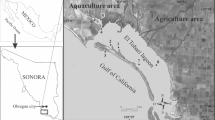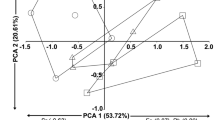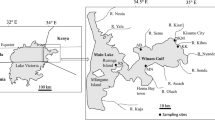Abstract
Clapper rails (Rallus longirostris) were used as an indicator species of estuarine marsh habitat quality because of their strong site fidelity and predictable diet consisting of mostly benthic organisms. Mercury (Hg) and the polychlorinated biphenyl (PCB) Aroclor 1268 concentrations were determined for sediments, crabs, as well as clapper rail adults and chicks collected from salt marshes associated with the LCP Superfund site in Brunswick, Georgia. Home ranges were established for adult rails, and sediment and crab samples were taken from each individual’s range. The study was designed to minimize the spatial variability associated with trophic transfer studies by choosing an endpoint species with a potentially small home range and specifically sampling its foraging range. The mean home range for clapper rails was 1.2 ha with a median of 0.28 ha. Concentrations of Hg and Aroclor 1268 were shown to increase with each trophic level. Transfer factors between media followed the same pattern for both contaminants with the highest between fiddler crabs and clapper rail liver. Hg and PCB transfer factors were similar between sediment to fiddler crab and fiddler crab to muscle, however the PCB transfer factor from fiddler crabs to liver was over twice as large as for Hg. PCB congener profiles did not significantly differ between media types.





Similar content being viewed by others
References
Baker Matta M, Linse J, Cairncross C, Francendese L, Kocan RM (2001) Reproductive and transgenerational effects of methylmercury or Aroclor 1268 on Fundulus heteroclitus. Environ Toxicol Chem 20:327–335
Bargar TA, Scott GI, Cobb GP (2001) Maternal transfer of contaminants: case study of the excretion of three polychlorinated biphenyl congeners and technical-grade endosulfan into eggs by white leghorn chickens (Gallus domesticus). Environ Toxicol Chem 20:61–67
Blandin WW (1963) Renesting, multiple brooding studies of marked clapper rails. Proc Ann Conf Southeastern Assoc Fish Wildlife Agencies 17:60–68
Castro OG, Vale C (1995) Total PCB-organic matter correlation in sediments from three estuarine areas of Portugal. Aquatic Ecol 29:297–302
Eddleman WR, Conway CJ (1998) Clapper rail (Rallus longirostris). In: Poole A, Gill F (eds) The birds of north america. The Birds of North America, Inc, Philadelphia, PA, USA
Eisler R (2000a) Handbook of chemical risk assessment: health hazards to humans, plants, and animals, Vol.1. Lewis Publishers, Boca Raton, FL
Eisler R (2000b) Handbook of chemical risk assessment: health hazards to humans, plants, and animals, Vol. 2. Lewis Publishers, Boca Raton, FL
EPA (1997) Mercury study report to congress, Volume VII: Characterization of health and wildlife risks from mercury exposure in the United States. EPA-452/R-97-09
EPA (2002) Georgia NPL/NPL Caliber Cleanup Site Summaries: LCP Chemicals Georgia Inc. Report # GAD099303182
Gaines KF, Cumbee JC, Stephens WL (2003) Nest characteristics of the clapper rail in coastal Georgia. J Field Ornithol 74:152–156
Gaines KF, Porter DE, Dyer SA, Wein GR, Pinder JE, Lehr Brisbin I (2004) Using wildlife as receptor species: a landscape approach to ecological risk assessment. Environ Manage 34:528–545
Gardner WS, Kendall DR, Odom RR, Windom HL, Stephens JA (1978) The distribution of methylmercury in a contaminated salt marsh ecosystem. Environ Pollut 15:243–251
Heard RW (1982) Observations on the food and food habits of clapper rails from tidal marshes along the east and Gulf Coast of the Eastern United States. Gulf Res Rep 7:125–135
Heinz G (1975) Effects of methylmercury on approach and avoidance behavior of mallard ducklings. Bull Environ Contam Toxicol 13:554–564
Kannan K, Maruya KA, Tanabe S (1997) Distribution and characterization of polychlorinated biphenyl congeners in soil and sediments from a superfund site contaminated with aroclor 1268. Environ Sci Technol 3:1483–1488
Kannan K, Nakata H, Stafford R, Masson GR, Tanabe S, Giesy JP (1998a) Bioaccumulation and toxic potential of extremely hydrophobic polychlorinated biphenyl congeners in biota collected at a superfund site contaminated with aroclor 1268. Environ Sci Technol 32:1214–1221
Kannan K, Smith JRG, Lee RF, Windom HL, Heitmuller PT, Macauley JM, Summers JK (1998b) Distribution of total mercury and methyl mercury in water, sediment, and fish from South Florida Estuaries. Arch Environ Contam Toxicol 34:109–118
Kannan K, Kawano M, Kashima Y, Matsui M, Giesy JP (1999) Extractable organohalogens (EOX) in sediment and biota collected at an estuarine marsh near a former chloralkali facility. Environ Sci Technol 33:1004–1008
Kie JG, Baldwin JA, Evans CJ (1996) CALHOME: a program for estimating animal home ranges. Wildl Soc Bull 24:342–344
King JK, Saunders FM, Lee RF, Jahnke RA (1999) Coupling mercury methylation rates to sulfate reduction rates in marine sediments. Environ Toxicol Chem 18:1362–1369
King JK, Kostka JE, Frischer ME, Saunders FM, Jahnke RA (2001) A quantitative relationship that demonstrates mercury methylation rates in marine sediments are based on the community composition and activity of sulfate-reducing bacteria. Environ Sci Technol 35:2491–2496
Lewis SA, Furness RW (1993) The role of eggs in mercury excretion by Quail Coturnix coturnix and the implications for monitoring mercury pollution by analysis of feathers. Ecotoxicology 2:55–64
Maruya KA, Lee RF (1998) Aroclor 1268 and toxaphene in fish from a Southeastern U.S. Estuary. Environ Sci Technol 32:1069–1075
Mills SA III, Thal DI, Barney J (2007) A summary of the 209 PCB congener nomenclature. Chemosphere 68:1603–1612
Nhan DD, Carvalho FP, Am NM, Tuan NQ, Yen NTH, Villeneuve JP, Cattini C (2001) Chlorinated pesticides and PCBs in sediments and molluscs from freshwater canals in the Hanoi region. Environ Pollut 112:311–320
NOAA (1998) LCP chemical site monitoring study. NOAA Technical Memorandum NOS OR&R5
Novak JM, Gaines KF, Cumbee JC, Mills GL, Rodriguez-Navarro AB, Romanek CS (2006) Clapper rails as indicator species of estuarine marsh health. Stud Avian Biol 32:270–281
Odom RR (1975) Mercury contamination in Georgia rails. Proceedings from the Annual Conference of the Southeastern Association of Fish & Wildlife Agencies 28:649–658
Rodriguez-Navarro AB, Gaines KF, Romanek CS, Masson GR (2002) Mineralization of clapper rail eggshell from a contaminated salt marsh system. Arch Environ Contam Toxicol 4:449–460
Rodriguez-Navarro AB, Romanek CS, Alvarez-Lloret P, Gaines KF (2006) Effect of in ovo exposure to PCBs and Hg on clapper rail bone mineral chemistry from a contaminated salt marsh in coastal Georgia. Environ Sci Technol 40:4936–4942
Roth RR, Newsom JD, Joanen T, McNease LL (1972) The daily and seasonal behavior patterns of the clapper rail in the Louisiana Costal Marshes. Proceedings from the Annual Conference of the Southeastern Association of Fish & Wildlife Agencies 26:136–159
Swihart RK, Slade NA (1985) Influence of sampling interval on estimates of home-range size. J Wildl Manage 49:1019–1025
Windom H, Gardner W, Stephens J, Taylor F (1976) The role of methylmercury production in the transfer of mercury in a salt marsh ecosystem. Estuar Coast Mar Sci 4:579–583
Zembal R, Massey BW, Fancher JM (1989) Movements and activity patterns of the light-footed clapper rail. J Wildl Manage 53:39–42
Acknowledgments
We followed an animal welfare protocol approved by the University of Georgia Institutional Animal Care and Use Committee (A960205). We thank Greg Masson and Keith Hastie with the U.S. Fish and Wildlife Service, Brunswick, Georgia for their support with this project. We thank Heather Brant for laboratory support. Field studies were supported in part by a grant from the M.K. Pentecost, Trust Fund of the Savannah Presbytery of the Presbyterian Church (USA). This research was also supported by the Environmental Remediation Sciences Division of the Office of Biological and Environmental Research, U.S. Department of Energy, through Financial Assistance Award No. DE-FC09-96- SR18546 to the University of Georgia Research Foundation. Editorial comments from Cham E. Dallas improved this manuscript.
Author information
Authors and Affiliations
Corresponding author
Rights and permissions
About this article
Cite this article
Cumbee, J.C., Gaines, K.F., Mills, G.L. et al. Clapper rails as indicators of mercury and PCB bioavailability in a Georgia saltmarsh system. Ecotoxicology 17, 485–494 (2008). https://doi.org/10.1007/s10646-008-0202-4
Received:
Accepted:
Published:
Issue Date:
DOI: https://doi.org/10.1007/s10646-008-0202-4




